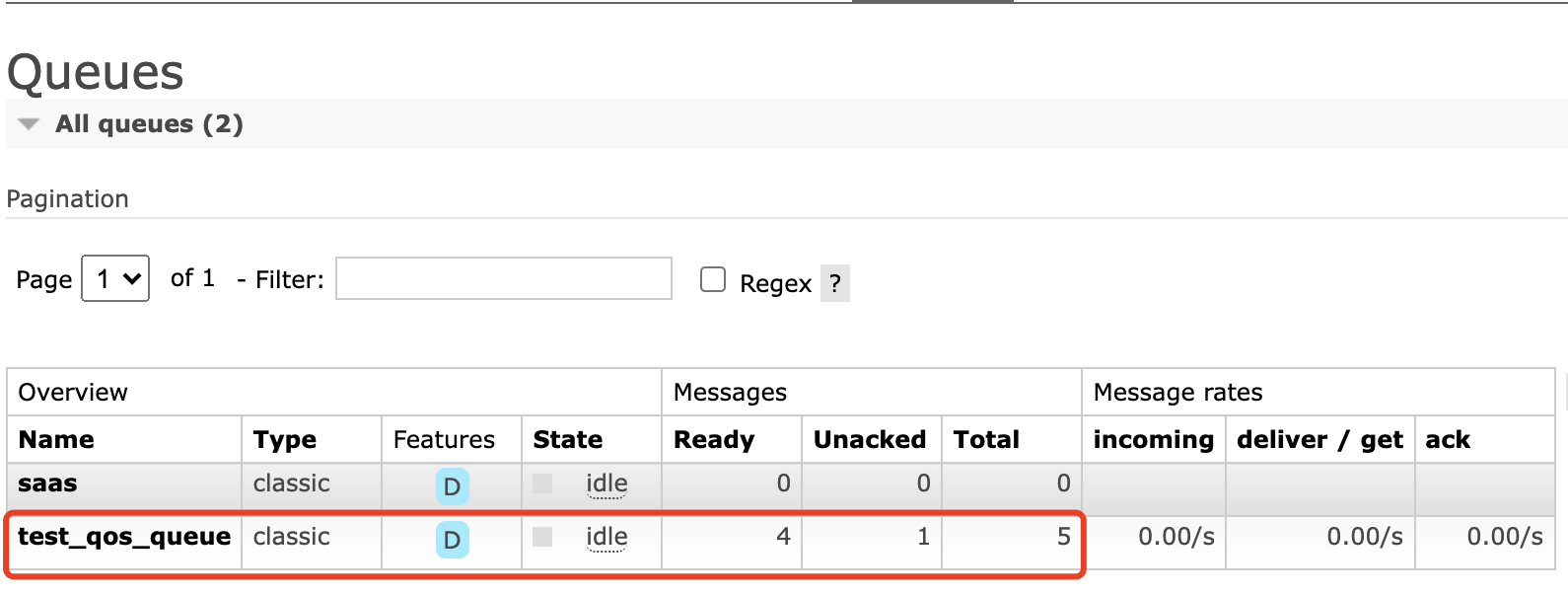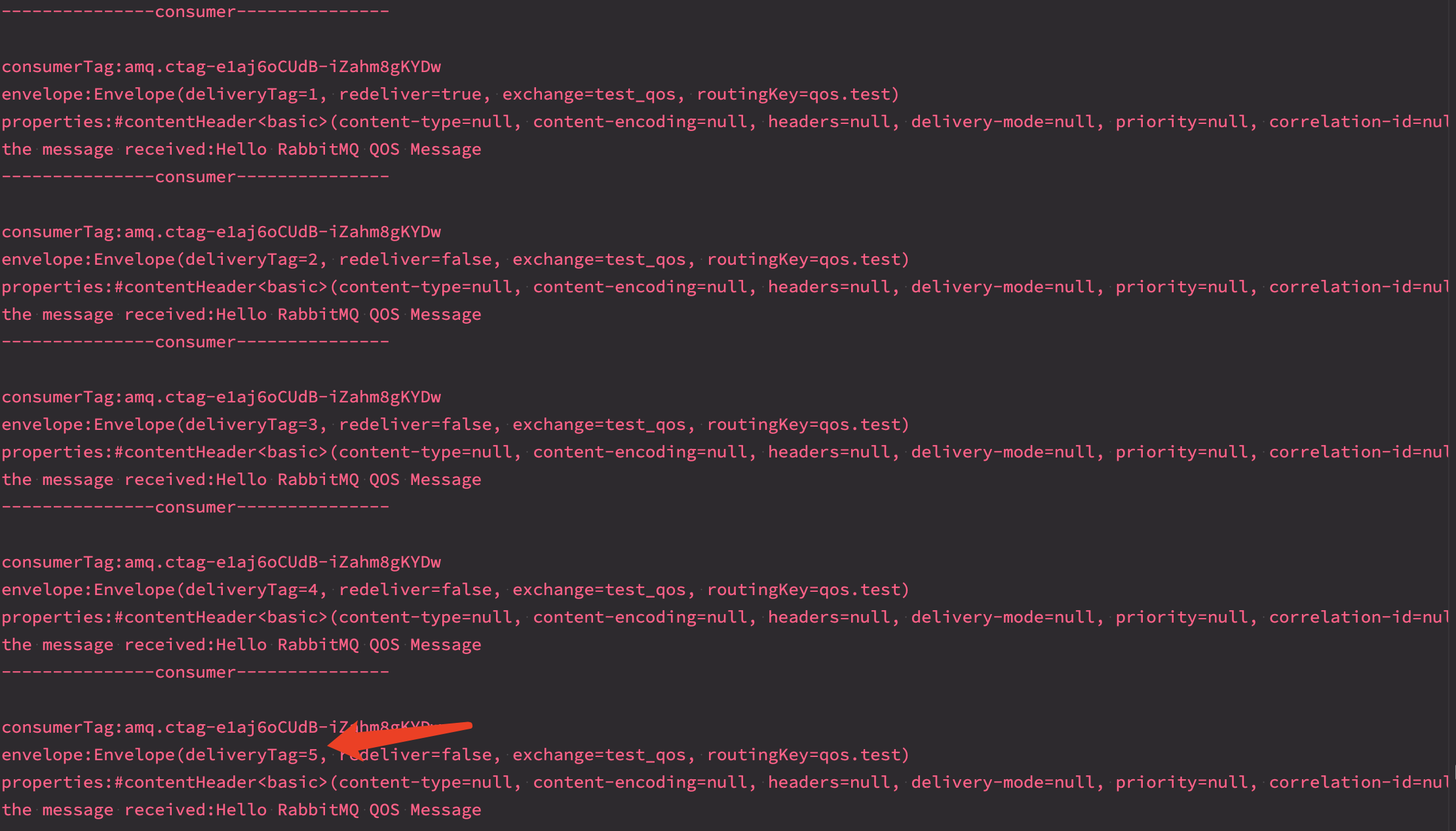RabbitMQ限流机制(五)
在服务端的稳定系的体系质量保障中,一个是考虑在客户端高并发的请求后,服务端如何能够
接收所有的请求并且服务端能够顶得住洪流的负载。这中间就需要涉及考虑调度机制和队列机制。比
如在2022年中,西安一码通是崩溃了又崩溃,这就是很典型的在高可用设计和稳定性体系建设方面
缺少系统化的思考。作为主流的核心中间件RabbitMQ,也是考虑到了限流的机制。
一、为什么要限流?
如果生产者批量发送消息,但是消费者接收的能力是很慢,那么就会导致堆积的MQ的消息越
来越多,最后导致无法承受,从而出现崩溃,这种情况是最不愿意看到的情况。那么我们可以把限流
解释为RabbitMQ把收到的消息没来得及处理(可能是资源也可能是其他情况),但是这个时候生产
者推送了批量的消息过来,单个客户端无法承受这么多的数据流量,最后结果就是崩溃,从而影响
业务端使用的客户,给客户造成了损失。
二、RabbitMQ限流机制
在RabbitMQ消息队列服务器中,限流机制主要是由消费者来承载,这其实从逻辑上是很好理解
的,毕竟消费者端是作为接收端,而生产者作为发送端是不需要限流的策略机制的。在RabbitMQ中提
供了QOS的功能,也可以说是服务质量保障,它可以解决消费端存在大批量的消息的时候进行限流。使
用到的方法具体是BasicQos。使用限流的前提是手工签收,不是自动签收,也就是basicConsumer方
法中的autoAck的参数,需要把该参数设置为false,也就是手工签收。
三、限流案例实现
3.1、生产端的代码
package com.example.rabbitmq.currentLimit;
import com.rabbitmq.client.*;
public class ProducerLimit
{
private static final String exchangeName="test_qos";
private static final String routyKey="qos.test";
public static void main(String[] args) throws Exception
{
ConnectionFactory connectionFactory = new ConnectionFactory();
connectionFactory.setHost("101.**.***.84");
connectionFactory.setPort(5672);
connectionFactory.setUsername("wuya");
connectionFactory.setPassword("java");
connectionFactory.setVirtualHost("/");
Connection connection = connectionFactory.newConnection();
Channel channel = connection.createChannel();
String msg = "Hello RabbitMQ QOS Message";
for(int i=0;i<5;i++)
{
channel.basicPublish(exchangeName,routyKey,true,null,msg.getBytes());
}
}
}
3.2、消费端的代码
package com.example.rabbitmq.currentLimit;
import com.example.rabbitmq.MyConsumer;
import com.rabbitmq.client.Channel;
import com.rabbitmq.client.Connection;
import com.rabbitmq.client.ConnectionFactory;
public class ConsumerLimit
{
private static final String EXCHANGE = "test_qos";
private static final String queueName="test_qos_queue";
private static final String routingKey="qos.#";
public static void main(String[] args) throws Exception
{
try{
ConnectionFactory connectionFactory=new ConnectionFactory();
connectionFactory.setHost("101.**.***.84");
connectionFactory.setPort(5672);
connectionFactory.setUsername("wuya");
connectionFactory.setPassword("java");
connectionFactory.setVirtualHost("/");
Connection connection=connectionFactory.newConnection();
Channel channel=connection.createChannel();
channel.exchangeDeclare(EXCHANGE,"topic",true,false,null);
channel.queueDeclare(queueName,true,false,false,null);
channel.queueBind(queueName,EXCHANGE,routingKey);
channel.basicQos(0,1,false);
//设置手工签收的方式,限流的前提是必须把autoAck设置为false
channel.basicConsume(queueName,false,new MyConsumer(channel=channel));
}catch (Exception e){
e.printStackTrace();
}
}
}备注:在如上的代码中,在方法basicQos中,第二个参数prefetchCount设置为1,表示的是生产者给消费者一个
消息后,等待消费者ack处理完成后,然后再接收新的消息,第三个参数global设置为false表示的是consumer级
别,而不是channel级别的消息。
3.3、自定义接收消息
package com.example.rabbitmq;
import com.rabbitmq.client.AMQP;
import com.rabbitmq.client.Channel;
import com.rabbitmq.client.DefaultConsumer;
import com.rabbitmq.client.Envelope;
import java.io.IOException;
public class MyConsumer extends DefaultConsumer
{
private Channel channel;
/**
* Constructs a new instance and records its association to the passed-in channel.
*
* @param channel the channel to which this consumer is attached
*/
public MyConsumer(Channel channel)
{
super(channel);
this.channel=channel;
}
@Override
public void handleDelivery(
String consumerTag,
Envelope envelope,
AMQP.BasicProperties properties,
byte[] body) throws IOException
{
System.err.println("---------------consumer---------------\n");
System.err.println("consumerTag:"+consumerTag);
System.err.println("envelope:"+envelope);
System.err.println("properties:"+properties);
System.err.println("the message received:"+new String(body));
// channel.basicAck(envelope.getDeliveryTag(),false);
}
}3.4、案例结果
执行如上的代码,可以在RabbitMQ控制台就能够看到限流的机制,消费者返回的消息具体如下:
---------------consumer---------------
consumerTag:amq.ctag-wx7ky-PxTenMX7Q8MbeoXA
envelope:Envelope(deliveryTag=1, redeliver=false, exchange=test_qos, routingKey=qos.test)
properties:#contentHeader<basic>(content-type=null, content-encoding=null, headers=null, delivery-mode=null, priority=null, correlation-id=null, reply-to=null, expiration=null, message-id=null, timestamp=null, type=null, user-id=null, app-id=null, cluster-id=null)
the message received:Hello RabbitMQ QOS Message在RabbitMQ的WEB控制台中就会显示出存在的总的消息是5,等待中的消息是4,等待ack签收的消息是1个,
具体如下展示:

我们针对消费者接收消息的代码进行完善,具体如下:
package com.example.rabbitmq;
import com.rabbitmq.client.AMQP;
import com.rabbitmq.client.Channel;
import com.rabbitmq.client.DefaultConsumer;
import com.rabbitmq.client.Envelope;
import java.io.IOException;
public class MyConsumer extends DefaultConsumer
{
private Channel channel;
/**
* Constructs a new instance and records its association to the passed-in channel.
*
* @param channel the channel to which this consumer is attached
*/
public MyConsumer(Channel channel)
{
super(channel);
this.channel=channel;
}
@Override
public void handleDelivery(
String consumerTag,
Envelope envelope,
AMQP.BasicProperties properties,
byte[] body) throws IOException
{
System.err.println("---------------consumer---------------\n");
System.err.println("consumerTag:"+consumerTag);
System.err.println("envelope:"+envelope);
System.err.println("properties:"+properties);
System.err.println("the message received:"+new String(body));
channel.basicAck(envelope.getDeliveryTag(),false);
}
}这地方设置的是非批量的方式来接收消息,我们就可以看到再次启动消费者的程序后,就会看到每个
消息都会有一个确认ack的过程,具体如下:

四、稳定性的保障体系思考
我一直认为作为一个质量保障工程师,在稳定系的体系建设方面的前提是我们需要懂得后端涉及到的技术,那么
知道具体的技术,我们几可以设计对应的测试用例以及测试场景,来验证后端这部分的稳定性,比如针对限流部分,那
么我们可以模拟生产者端,批量的往消费者端写数据,来验证消费者端在无法消费的情况下,它的处理逻辑以及限流机
制的合理性,这中间,不管是限流还是不限流,其实都是为客户服务的思考路线,那么限流了,是否影响客户的正常使用?
如果影响了,这个影响点具体是什么,有哪些,质量保障团队都需要通过测试验证,来拿出一个评估的数据。感谢您
的阅读,您也可关注我的公众号:


